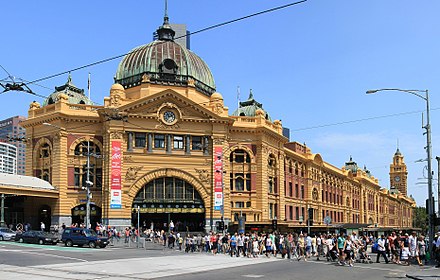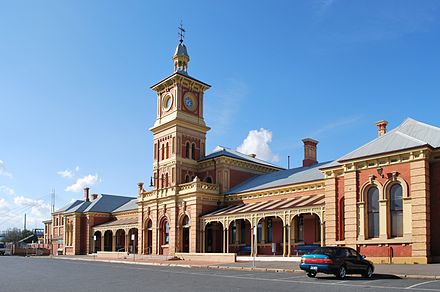Rail travel in Australia
Rail travel in Australia
Although trains in Australia are not as ubiquitous or frequent as in East Asia or Europe, travelling in Australia by train could be an interesting way to cross the country. Unfortunately, outside the main Brisbane-Sydney-Melbourne corridor, Australia's sparse population means the rail network is considerably underdeveloped; trains usually take longer than driving yourself, and often work out more expensive than flying. A journey across the Outback by train, however, is an experience in itself, and allows you to admire the sheer vastness of the Australian Outback, which may be more difficult if you're driving.
Understand


Prior to the advent of the automobile and air travel, trains formed the backbone of Australia's transportation network, and were frequently used to travel from country towns to their respective state capitals. After World War II, rail transport in Australia fell into a steep decline from which it never recovered. Many country lines were closed, while many others were reduced to serving only freight traffic. Today, passenger rail services in Australia continue to lag behind much of the rest of the developed world, and most of the intercity and country rail lines are primarily used for freight traffic, particularly the products of Australia's vast mining enterprises.
Since the beginning, the building and operation of railways in Australia had largely been left to the individual states, with different states even using different gauges. Authorities in London saw the problem early on and tried to intervene, but unlike in Ireland, they failed. As a result of a lack of cooperation, the railway network of each state for the most part developed independently of the others, and at one point taking the train between two different states would require a break-of-gauge. The Melbourne-Adelaide railway was an exception: it was completed using a single broad gauge in 1887. Nevertheless, from the 1930s to 1990s, interstate lines were progressively converted to standard gauge, thus allowing through-services between most of Australia's mainland capital cities. The final stretch of Australia's national rail network, the Adelaide-Darwin line, was only completed (primarily to serve freight trains) in 2004.
Scheduled long-distance passenger rail services are provided by a mix of state government operators and a single private operator. Other tourist and touring services are operated by various operators including historic societies and community groups. There is no single centralised ticketing system covering all the different operators. This means that you will have to buy separate tickets if your journey involves multiple operators.
Long distance rail services in Australia are not modern high-speed or fast-rail services. If you're not a rail travel enthusiast, you should compare other travel options - flying, coach or self-drive - as you may find these faster, cheaper and more comfortable. This is especially the case when you're travelling between cities.
Intercity
Journey Beyond
See also: Across Australia by train
Private operator Journey Beyond (known as Great Southern Rail up to 2019) is the primary operator of intercity trains in Australia, including both transcontinental lines. Their trains are slower than driving yourself, but relatively luxurious and more expensive than flying, meaning that they are primarily geared towards those who have a lot of time and money on their hands for a leisurely journey of luxury across the country. Journey Beyond also offers private carriages for hire on their routes, if you are willing to pay the steep premium for that privilege; check with their web-site for details.
- The Ghan operates between Adelaide and Darwin via Alice Springs
- The Indian Pacific runs between Sydney and Perth via Adelaide, and is Australia's longest passenger rail service, as well as the only passenger train service crossing the vast and remote Nullarbor Plain.
- The Overland operates between Adelaide and Melbourne.
- The Great Southern runs between Adelaide and Brisbane. Only operates one train a week in each direction during the summer months.
With the exception of The Overland, all the other service have adopted an all-sleeper configuration, with meals in the restaurant car being included in the price of the fare. No sleeper cars are available on The Overland, as the journey is covered within a day during daylight hours. Meals are also not included in the ticket price on The Overland, which does not have a restaurant car, though food may be purchased in the cafe car. Motorail service (bringing your car on the train with you) is available for those travelling from Adelaide to Perth and vice-versa on The Indian Pacific, and for those travelling from Adelaide to Darwin and vice-versa on The Ghan.
Others
Some other intercity trains are operated by the state government operators. These are typically cheaper, though not as luxurious as the trains run by Journey Beyond.
- Queensland Rail operates the Spirit of Queensland between Brisbane and Cairns.
- NSW Trainlink operates the Brisbane XPT between Sydney and Brisbane, the Melbourne XPT between Sydney and Melbourne, and the Canberra XPLORER between Sydney and Canberra.
Sleeper cars are available on the overnight Brisbane XPT and Melbourne XPT trains, but not on the daytime runs of those trains or the Canberra XPLORER. Meals are not included the price of the ticket, though food is available for purchase at inflated prices in the cafe cars. The Spirit of Queensland, on the other hand, offers a "RailBed" service, which is akin to international business class on most major airlines, meaning you get a seat that can recline fully into a bed for you to sleep. Meals are included in the price of the "RailBed" service but not for the regular "premium economy" seats, though food is available for purchase in the club lounge car. None of these services have a restaurant car, though meals are served to your seat in airline international business class style for Spirit of Queensland "RailBed" passengers.
Country rail
Country rail services are provided by the state government operators, with networks that radiate out of the four largest state capitals of Sydney, Melbourne, Brisbane and Perth. There are no passenger country rail services in South Australia or the Northern Territory, and no passenger rail services at all in Tasmania, with its network being used exclusively for freight transport.
- NSW Trainlink operates rail services to country New South Wales from Central Railway Station in Sydney.
- V/Line operates rail services to country Victoria from Southern Cross Station in Melbourne.
- Queensland Rail operates most rail services to country Queensland from Roma Street Station in Brisbane, and a few services from Townsville and Cairns. The Spirit of the Outback from Brisbane to Longreach via Rockhampton features sleeper carriages and a restaurant car.
- Transwa operates most services from East Perth Railway Station in Perth to various country towns in the south of Western Australia, with the Australind service to Bunbury operated out of Perth Railway Station.
In addition to these services, there are also several lines served by heritage railways. These lines typically use steam locomotives, operate over short distances, and are isolated from the main railway lines. They are geared almost exclusively towards tourists looking for a nostalgic experience.
Urban rail
Urban commuter rail services are available in Australia's five largest cities: Sydney, Melbourne, Brisbane, Perth and Adelaide. If travelling from a train-served suburb to the city centre, at least in the former four, train travel is often the most convenient way to travel due to traffic congestion and expensive parking spaces.
- Sydney Trains operates the suburban train network of Sydney. Sydney is also home to Australia's only Metro system, with a single line that opened in May 2019.
- Metro Trains Melbourne operates Melbourne's suburban train network. Melbourne is also home to the largest tram network in the world.
- Queensland Rail operates the suburban train network of Brisbane, which includes connections to the Gold Coast.
- Transperth operates the suburban train network of Perth, with connections to the port city of Fremantle.
- Adelaide Metro operates the suburban train network of Adelaide, and a single tram line to the popular beach suburb of Glenelg.
Related: Rail travel in New Zealand
Related: Across Australia by train
